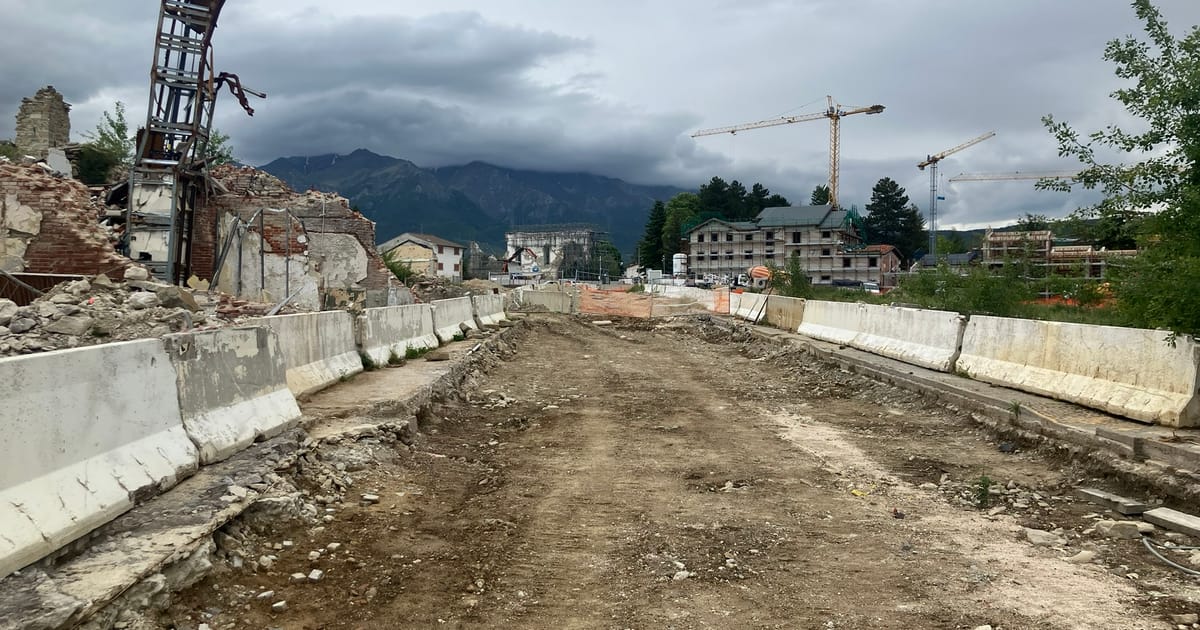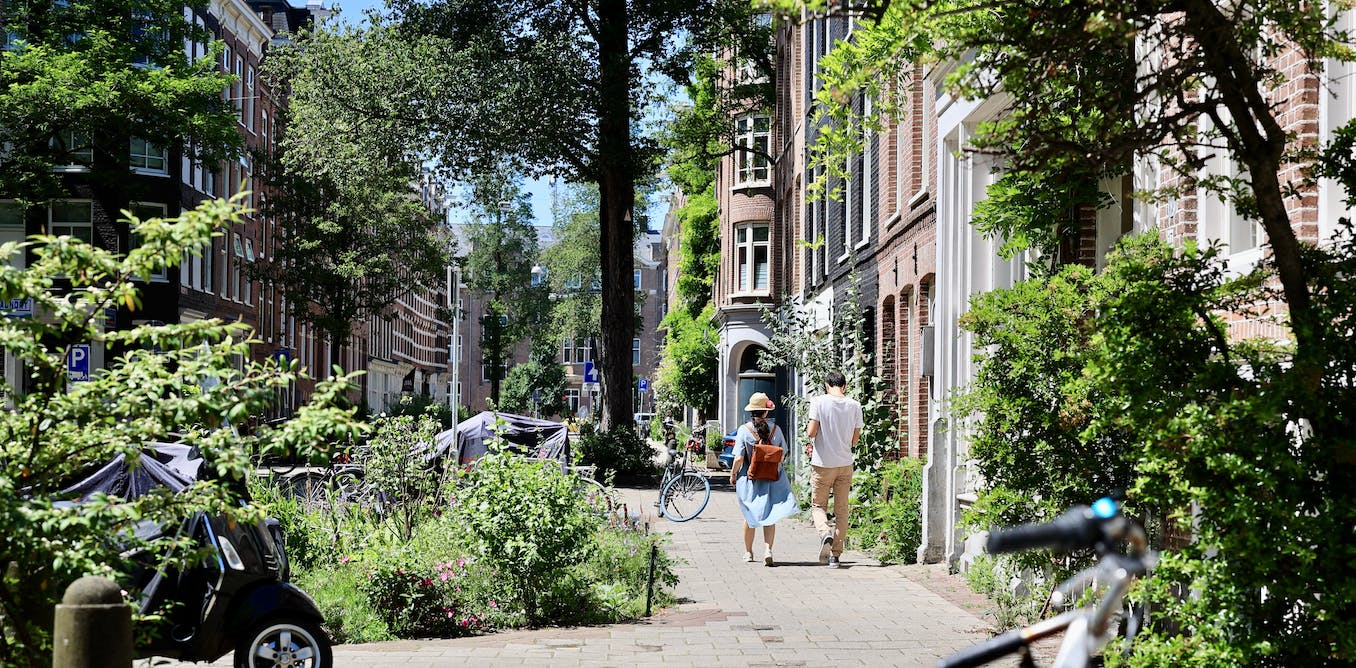AMATRICE, Italy — Gaetano Galli surveyed the quiet street and casually pointed out where the earthquake had wrought its havoc. There, the splintered wreck of a bungalow that caved in on a family of six; across the road, the spot where over a dozen were crushed under the weight of a multi-storey villa. Finally, he turned to the pile of rubble that was once his own home.
“The night of the 24th, I was inside,” he recalled, indicating where the roof had cratered, causing the supporting walls to disintegrate. “I had a kid of four years and a baby of nine months. They survived, thank God.”
Galli, a compact, paint-stained 51-year-old with a silver beard and bright blue eyes, heads a local construction consortium rebuilding the tiny hilltop town of Amatrice, which was devastated by an earthquake in 2016. In recent months, after years of dithering, reconstruction has finally begun in earnest, and in place of some of the flattened homes already stand several gleaming newbuilds, symbols of a newfound momentum.
But yet again, the process threatens to stall before it can even get out of first gear. The reason? A pandemic-era tax credit scheme that has wrecked the Italian budget and is now one of the biggest headaches for Prime Minister Giorgia Meloni.
Many of the rebuilding projects have used the so-called ‘Superbonus’ scheme to make their numbers add up. But the Superbonus has been more curse than blessing for the town since former Prime Minister Giuseppe Conte created it in 2020. While it has increased the amount of resources notionally devoted to reconstruction, it has added layers of complexity to a process already hobbled by bureaucracy.
Now, under heavy pressure from the EU to get the budget deficit under control, Meloni is now drastically pruning the scheme — and that’s casting fresh doubt over Amatrice’s ability to recover.

Shaken, not repaired
The 6.2 magnitude earthquake that shook much of central Italy in 2016 hit nowhere quite so badly as Amatrice, a medieval commune set in the spectacular wooded mountain ranges of eastern Lazio. The quake, along with a series of powerful aftershocks, left around 90 percent of Amatrice’s 2,646-strong population homeless and 234 dead.
For the better part of a decade, efforts to rebuild made scant progress thanks to bureaucratic hurdles and a glacial official investigation into the scale of the destruction. Today, around half of Amatrice’s homes are yet to be fully repaired, and the town’s millennium-old center remains a scarred wasteland, with one lone clocktower still standing amid heaps of shattered concrete and roiled earth. Windowless shells of old apartment blocks haunt the immediate outskirts; none of Amatrice’s four ancient churches remain fit for the faithful.
While the simpler homes in the peripheries were quickly restored, residents of the old town still live in emergency prefabs built right after the earthquake. Much of the town’s ecosystem of life and commerce has been remade in tacky newbuilds along the flanks of a mountain freeway. A strip mall is housed in what looks like a storage container, and the town’s best restaurants — serving up the native bucatini all’Amatriciana dish — have been reimagined in an incongruous modernist glass-and-polished-wood style, reminiscent of a gentrified inner-city food court.
Unintended consequences
Looming large over the reconstruction effort is the controversial Superbonus. Debuted in mid-2020 to help the Italian economy recover from its pandemic slump, the scheme allowed homeowners to recoup up to 110 percent of the costs of sustainable home renovations through tax credits spread over four to five years. Critically for Amatrice, it also earmarked some €400 million for the towns destroyed in the 2009 and 2016 earthquakes, to supplement existing contributions from the state and “accelerate” reconstruction.
Initially, however, the Superbonus only hurt Amatrice. The surge in demand that attended its rollout wildly inflated the cost of construction materials. Cash-strapped construction firms gave up and decamped to places where they would only have to deal with modest energy improvements rather than full-scale reconstruction.
“We were punished,” said Amatrice mayor Giorgio Cortellesi in the drab improvised office space that now serves as the town hall. “Italians are cunning, if there’s a way to make money easily, they will take it — and it was easier to make money from the Superbonus in places like Rome.”

Officials cite the case of the Don Minozzi complex, a stately orphanage resembling a Carthusian monastery in miniature, which once stood tall at the fringes of the small town. The earthquake left it a partial ruin, leaving cracked brickwork and dark maws where large windows once let the light in.
In 2021, plans emerged for a bold new design that would transform the complex into a sleek “Casa Futuro” with facilities for tourists, jobseekers and the faithful. But building stalled as the costs piled up, and the four-firm consortium behind the project abandoned ship before the work was done. Three of the four firms didn’t respond to a request for comment, while one could not be reached.
Only last month did a second firm agree to take up the task, and the Don Minozzi house, like much else, remains a dilapidated wreck three years on.
Ill-suited subsidy spurs precarious revival
In the years following its launch, it gradually became clear that the cost of the Superbonus had been dramatically underestimated, after lax enforcement led to thousands of homeowners commencing works without filing official applications. Its total expected cost ballooned to €219 billion, over six times the €35 billion predicted by Conte. In 2023, Meloni’s government hurriedly imposed a deadline on new applications, while winding down another option allowing homeowners to transfer their credits to banks and firms.
That proved a surprising boon for earthquake-stricken towns like Amatrice, where residents were granted an extension permitting them to use the scheme’s full benefits until December 2025. As the Superbonus lost steam elsewhere, builders suddenly had an incentive to return to the tougher work of earthquake rehabilitation.
And so they did. Today, Amatrice bustles with construction workers in dusty overalls, manning Komatsu diggers and shifting great mounds of earth. Owing to the lack of habitable space in the town, many live in the two remaining hotels (both destroyed and subsequently rebuilt), while others occupy the prefabricated houses built for residents.

Now, as much as 20 percent of the reconstruction depends on the Superbonus, according to Guido Castelli, an Italian senator charged with overseeing earthquake-stricken towns. While there is no specific data for Amatrice, new applications across earthquake-stricken zones after March 2024 surged from low levels to around €121.5 million.
However, that increased dependence may also prove fatal. The fiscal impact of the Superbonus is one reason why Italy’s budget deficit surged to 7.4 percent of GDP in 2023, putting it on collision course with Brussels. Italy, along with several other European countries including France, is now obliged to economize, and the Superbonus has become an obvious target.
Just in March, Finance Minister Giancarlo Giorgetti threatened to scrap all the privileges afforded to Amatrice, along with the three other earthquake-devastated towns in similar positions. Pressure from Castelli forced Giorgetti to back down, but the 2025 deadline threatens to put the Superbonus out of reach for many projects which, because of the scale of the destruction, are vastly more difficult to arrange than simple refurbishments elsewhere.
Galli, for instance, works for a consortium of homeowners that transferred its tax credit to his firm, Matrix. Before Giorgetti’s crackdown, he might have sold that credit to a bank at a discount for immediate cash. But political risk has made banks unwilling to take new credits on. Firms must instead foot the immense initial costs themselves.
Consequently, Galli said he has been forced to work much more slowly to avoid stumbling into an unmanageable liquidity crisis. In the past three years, he said, Matrix has hemorrhaged around €30 million — and has so far only been able to recoup €450,000.
Homeowners are also entitled to larger credits under the Superbonus if they include green improvements such as heat pumps in their designs. But in some cases, Galli said, disbursal of the related tax credits often requires certain “usability” standards to be met. Achieving that may depend on the restoration of ruined public infrastructure, which can take years and fall outside the remit of an individual project. With funding thus delayed, projects mid-construction grind to a halt.

By way of example, Galli walked up to the fenced-off entrance to the vast muddy expanse that remains of the town’s old center, indicating one of the houses his firm is helping to build. Next to it was a huge ditch awaiting the introduction of plumbing, a process that will depend on the completion of full-scale town planning that could be decades in the making.
For some, that’s a lot of unnecessary pain.
“I’m rebuilding a house that was the subject of a tragedy — why should I have all these bureaucratic obstacles?” asked Romeo Bucci, a specialist involved in the reconstruction. Castelli agreed, saying he hopes to eventually liberate Amatrice from the scheme altogether, and instead increase the size of the official earthquake fund.
To Cortellesi, the mayor, the Superbonus should have been limited to homeowners looking to bolster energy efficiency. It should not, he said, have been used for something as elemental as putting a roof over people’s heads.
The Superbonus is useful to “incentivize reconstruction for an economic rebound,” he said. “But not for reconstruction — not to restore what once was.”
And reconstruction remains the overriding priority for all. The goal, says Castelli, is to rebuild Amatrice to an approximation (with better earthquake protections, of course) of what it once was, a new iteration of the hilltop settlements that have characterized this landscape since pre-Roman times.
“If we don’t do this,” Castelli stressed, “Italy would no longer be Italy.”




